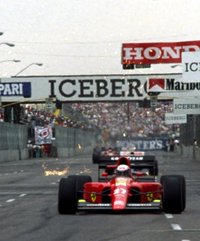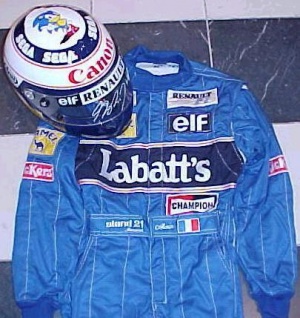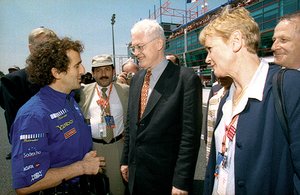Alain Prost
| Alain Prost | |
|---|---|
| Image | Alain Prost 1991 United States GP.jpg |
| Nationality | French |
| Years | 1980–1991, 1993 |
| Team(s) | McLaren, Renault, Ferrari, Williams |
| Races | 202 (199 starts) |
| Championships | 4 (1985, 1986, 1989, 1993) |
| Wins | 51 |
| Podiums | 106 |
| Points | 768.5 (798.5) |
| Poles | 33 |
| Fastest laps | 41 |
| First race | 1980 Argentine Grand Prix |
| First win | 1981 French Grand Prix |
| Last win | 1993 German Grand Prix |
| Last race | 1993 Australian Grand Prix |
| Alain Prost | |
|---|---|
| SHORT DESCRIPTION | Retired French Formula One Driver |
| DATE OF BIRTH | 24 February 1955 |
| PLACE OF BIRTH | Saint-Chamond, France |
Alain Marie Pascal Prost, OBE (born 24 February 1955) is a French racing driver. He retired from Grand Prix racing at the end of 1993 after becoming Formula One World Champion for the fourth time. Only Juan Manuel Fangio and Michael Schumacher have won more Formula One World Drivers' Championship titles. From 1987 until 2001 Prost held the record for most Grand Prix victories. Schumacher surpassed Prost's total of 51 victories at the 2001 Belgian Grand Prix . Prost now races on ice in the Andros Trophy.
Prost discovered karting at the age of 14 during a family holiday. He progressed through motor sport's junior ranks, winning the French and European Formula Three championships, before joining the McLaren Formula One team in 1980 at the age of 25. He finished in the points on his Formula One debut and took his first race victory at his home Grand Prix in France a year later, while he was driving for the Renault Factory team.
Prost employed a smooth, relaxed style behind the wheel, deliberately modelling himself on personal heroes like Jackie Stewart and Jim Clark. He was nicknamed 'The Professor' for his intellectual approach to competition. Skilled at setting up his car for race conditions, Prost would often conserve his brakes and tyres early on in a race, leaving them fresher for a challenge at the end of the race. During the late 1980s and early 1990s, Prost formed a fierce rivalry with Ayrton Senna, who joined him at McLaren in 1988. The two had a series of controversial races, including a collision at the 1989 Japanese Grand Prix that gave Prost his third Drivers' Championship. A year later at the same venue they collided again, but this time Prost, driving for Ferrari, lost out. After a dismal 1991 and a sabbatical in 1992, Prost joined the Williams team, where he dominated the 1993 season before finally retiring at the end of the year. In 1997, Prost took over the French Ligier team, running it as Prost Grand Prix until it went bankrupt in 2001. In 2006, Prost started his fourth year in the Andros Trophy, which is an ice racing competition.
Motor sport journalist Denis Jenkinson described Prost as "a very warm and uncomplicated man who doesn't rely on passion or inspiration. Nor does he indulge in showmanship or bullshit. He is capable of a level of mental discipline beyond the comprehension of most people."
Personal and early life
Alain Prost was born near Saint-Chamond, in the département of Loire in France to André and Marie-Rose Prost, who was of Armenian descent. Prost had one younger brother called Daniel, who died of cancer in September 1986. Although short, Prost was an active, athletic child, who enthusiastically took part in diverse sports, including wrestling, roller skating and football. In doing so he broke his nose several times. He considered careers as a gym instructor or a professional footballer before he discovered kart racing at the age of 14 while on a family holiday. This new sport quickly became his career of choice.
Prost is married to Anne-Marie (born 14 February 1955). They have two sons, Nicolas (born 18 October 1981) and Sacha Prost (born 30 May 1990). Prost also has a daughter, Victoria. As of 2007, Nicolas races in the Spanish Formula 3 championship for the Campos Racing team. Prost lived in his hometown, Saint-Chamond, until he and his Renault team fell out in the early 1980s. In April 1983 the Prost family moved to La Muraz, Switzerland and lived there until November 1999, when they moved to Nyon in the same country.
Driving career
Pre-Formula One
Prost won several karting championships in his teens. In 1974 he left school to become a full-time racer, supporting himself by tuning engines and becoming a kart distributor. His prize for winning the 1975 French senior karting championship was a season in French a category in which he won the title and all but one race in 1976.
Prost went on to win the 1977 Formula Renault European championship before moving up to Formula Three (F3) in 1978. In 1979 he won both the French and European F3 championships, by which time he was on the shopping lists of several Formula One teams. After carefully considering his options, he chose to sign with McLaren for 1980. He surprised the British team by declining their offer of a race drive in a third car at the final race of the 1979 season — reasoning that the token effort would benefit neither him or the team.
Formula One
1980: McLaren
Related article: McLaren
Alain Prost began his career with McLaren in 1980 alongside Ulsterman John Watson. On his debut in Argentina he finished in sixth place earning one point, something achieved by only a handful of drivers. Prost added four more points to his tally during the season, scoring points in Brazil, Britain and the Netherlands. Prost finished the year 15th in the drivers' championship, equalling points with former world champion Emerson Fittipaldi. Despite the encouraging debut season, Prost had several accidents, breaking his wrist in one of them and suffering a concussion in another. At the end of the season, despite having two years remaining on his contract, he left McLaren and signed with Renault. Prost has said that he left because of the large number of breakages on the car and because he felt the team blamed him for some of the accidents.
1981–1983: Renault
Related article: Renault F1
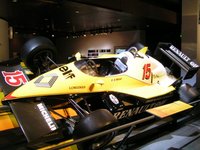
- 1981
Prost was partnered with fellow Frenchman René Arnoux for 1981. Motor sports author Nigel Roebuck reports that there were problems between Prost and Arnoux from the start of the season, Prost being immediately quicker than his more experienced teammate. He did not finish the first two Grands Prix, due to collisions with Andrea de Cesaris in Long Beach and Siegfried Stohr in Jacarepaguá, but scored his first podium finish in Argentina. He retired in the next four races before winning his first Formula One race at his home Grand Prix in France, finishing two seconds ahead of his old teammate John Watson. For Prost, his debut victory was memorable mostly for the change it made in his mindset. "Before, you thought you could do it," he said. "Now you know you can." Prost won two more races during the season, as well as his first pole position in the Netherlands and finished fifth in the drivers' championship, seven points behind champion Nelson Piquet.
- 1982
Prost won the first two Grands Prix of the 1982 season in South Africa and Brazil. He finished in the points on four other occasions, but did not win again. Despite retiring from seven races, Prost improved on his drivers' championship position, finishing in fourth, but with nine fewer points than the previous year. His relationship with Arnoux deteriorated further after the French Grand Prix. Prost believes that Arnoux, who won the race, went back on a pre-race agreement to support Prost during the race. His relationship with the French media was also poor. He has since commented that "When I went to Renault the journalists wrote good things about me, but by 1982 I had become the bad guy. I think, to be honest, I had made the mistake of winning! The French don't really like winners."
- 1983
Arnoux left Renault in 1983, and American Eddie Cheever replaced him as Prost's partner. Prost earned a further four victories for Renault during the season and finished second in the drivers' championship, two points behind Nelson Piquet. Piquet and the Brabham team overhauled Prost and Renault in the last few races of the season. Prost, who felt the team had been too conservative in developing the car, found himself increasingly at odds with Renault's management, who made him the scapegoat for failing to win a championship. In addition to that, the French fans recalled the bitter fight that had caused their favourite, Arnoux, to leave the team. Renault dropped Prost only two days after the last race of the season. He re-signed for McLaren for the 1984 season within days and moved his family home to Switzerland.
1984–1989: McLaren
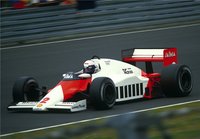
- 1984
The Frenchman joined double world champion Niki Lauda at McLaren in 1984, driving the McLaren MP4/2 using TAG-Porsche engines. He lost the world championship to Lauda in the final race by half a point, despite winning seven races to Lauda's five. The half point came from the Monaco Grand Prix, where Prost had been leading, albeit with Ayrton Senna and Stefan Bellof closing on him rapidly, when officials stopped the race at half distance due to heavy rain. Under Formula One regulations, Prost received only half of the nine points normally awarded for a victory.
- 1985
In 1985 Prost became the first French Formula One World Champion. He won five of the sixteen Grand Prix during the season. He also won on the road at the San Marino Grand Prix, but was disqualified after his car was found to be underweight in post-race scrutineering. Prost finished 23 points ahead of his closest rival, Michele Alboreto. Prost's performance in 1985 earned him the Légion d'honneur distinction in France.
- 1986
Niki Lauda retired in 1986, and was replaced at McLaren by 1982 Champion Keke Rosberg. Prost successfully defended his title, despite his car struggling against the Honda-powered Williams of Nelson Piquet and Nigel Mansell. Until the latter stages of the final race of the 1986 season, in Australia, Prost appeared set to finish third in the Championship, behind Mansell and Piquet. While leading, Mansell suffered a tyre failure at high speed, and crashed out. The Williams team called his teammate Piquet in to change tyres as a safety precaution, handing the race victory — and Championship — to Prost, who had already pitted. Another memorable race that year for Prost was at the San Marino Grand Prix. He was cruising to victory when his car began to run out of fuel three corners from the chequered flag. Frantically weaving the car back and forth to slosh the last drops of fuel into the pickup, he managed to keep it running just long enough to creep over the line and win the race. It happened again at the German Grand Prix: while running in fourth position, Prost's car ran out of fuel on the finishing straight of the last lap. Instead of retiring, Prost got out of his car and tried to push it to the finish, to great applause from the crowd. The finish line was too far, though, and he never reached it. He was classified sixth in the race, as the seventh-placed car was a lap behind.
- 1987
With Rosberg retiring from Formula One for the 1987 season, Stefan Johansson filled the seat thanks to his Marlboro connections. Even though Prost was driving an obsolete McLaren, he challenged Piquet and Mansell almost until the end, winning three races and breaking Jackie Stewart's record for race victories by winning for the 28th time. Prost considers the Brazilian Grand Prix as his best and most rewarding race ever. The Williams-Hondas had been dominant during qualifying, and Prost started fifth on the grid. He had worked on his race set-up, and with everyone else going for a high-downforce set-up, the Frenchman went the other way. The set-up meant less tyre wear, thanks to slower speeds in the corners while going fast down the straights. Only one stop was necessary, and Prost won the race by 40 seconds.
Prost finished the 1987 season in fourth, 30 points behind champion Nelson Piquet.
- 1988
Despite Nelson Piquet winning the Drivers' Championship and Williams winning the Constructors' Championship, Honda decided not to supply Williams with their engines and instead supplied the McLaren team for 1988. McLaren Honda dominated the season, winning 15 out of 16 races. Prost won seven and outscored his new teammate Ayrton Senna by 11 points, despite Senna winning one more race than Prost. However, only the 11 best results from the season counted toward the championship total, and this gave Senna the title by three points. This began the rivalry that pushed two of the sport's greatest drivers to unprecedented heights of success and controversy.
- 1989
McLaren's domination continued throughout 1989, and the Prost-Senna struggle for supremacy put them on a collision course. Mutual admiration turned to all-out hatred, with the Frenchman accusing his Brazilian teammate of "dangerous driving" and of receiving more than a fair share of attention from both McLaren and Honda. Their embittered season ended as many pundits had feared. In the Japanese Grand Prix at the end of lap 46, Senna made his move at the chicane. Prost turned into his teammate's path. The two interlocked McLarens slid up the chicane escape road. Prost, thinking the World Championship was over, climbed out of his car. To separate the cars, the marshals pushed Senna's McLaren backwards on to the track. This left it in a dangerous position, so they pushed it forwards again. As they did so, Senna bump-started the engine. He drove through the chicane and rejoined. The nose of his car was damaged and he had to pit, but he rejoined only five seconds behind Alessandro Nannini. On lap 50, Ayrton sliced past Nannini at the chicane to take the lead and won the race. But it was Nannini who appeared on the podium. Race officials had excluded Senna for missing the chicane. McLaren appealed the decision, but the FIA Court of Appeal not only upheld the decision but fined Senna US$100,000 and gave him a suspended six-month ban. So Prost had clinched his third driving title in controversial circumstances, and the Frenchman quickly moved from McLaren to join his new employers: Ferrari.
1990–1991: Ferrari
Related article: Scuderia Ferrari
- 1990
The Frenchman replaced Gerhard Berger at Ferrari and was partnered with Britain's Nigel Mansell for 1990. Prost won five races for Ferrari that year, in Brazil, Mexico, France, Britain and Spain. Notable among these was the Mexican Grand Prix, where he won after starting in 13th position. In both the Mexican and Spanish races, he led Mansell to Ferrari 1-2 finishes. The championship once again came to the penultimate round of the season in Japan with Prost trailing his McLaren adversary, Ayrton Senna, by nine points. As in 1989, a controversial collision between the two settled the race. At the first corner Senna, as he later admitted, intentionally drove his race car into Prost's, taking them both out of the race and sealing the title in his favour. "What he did was disgusting," Prost said. "He is a man without value." Prost finished the season seven points behind Senna, and his Ferrari team were runners-up to McLaren.
- 1991
In 1991, Mansell left the Scuderia, due to his unstable relationship with Prost, to join his previous employers, Williams. Mansell's replacement was Frenchman Jean Alesi, who had been impressive during the previous two years at Tyrrell. Ferrari could not cope with the other teams, and that season Prost won no races, only getting onto the podium five times. He took it out on the Italian team, publicly criticising them (he famously described his car as "a truck"), and was fired prior to the end of the season, right before the Australian Grand Prix. Prost was replaced by Italian Gianni Morbidelli.
1993: Williams
Template:Rellink Prost went onto a sabbatical year in 1992, which was dominated by Nigel Mansell in a Williams-Renault. After hearing that Prost would be his teammate again in 1993, Mansell left Williams to race in the CART series. The Frenchman was part of a new-look driver line-up at Williams, with rookie Damon Hill coming in to replace Riccardo Patrese, who had left to join Benetton.
Prost clinched his fourth, and final, title, but in a year where he was regularly challenged by Ayrton Senna in an inferior car. Shortly before the Portuguese Grand Prix in October 1993, Alain Prost announced he would not defend his world title and instead opted to retire as the most successful driver in the sport's history — a record which stood for almost a decade. On the podium in Adelaide in 1993, Prost's last race, he and Ayrton Senna embraced, and it was as if — now that Prost was no longer a rival — Senna saw no reason for any more hostility. Prost was surprised by the gesture. Prost's performances earned him an OBE.
German Michael Schumacher broke Prost's record of 51 Grand Prix wins during the 2001 season. However, the Frenchman still holds the records for the most Grand Prix starts in turbo powered cars (126), and most wins at home Grand Prix (six at the French Grand Prix).
Rivalry with Ayrton Senna
Alain Prost's battles with Ayrton Senna were particularly notable. The rivalry originated in 1988, when Senna joined Prost at the McLaren team. The most notable event during the season between the two occurred during the Portuguese Grand Prix, where Senna tried to block Prost from taking the lead by forcing the Frenchman to run close to the pitwall; Prost managed to edge Senna outwards, taking the lead as they went into the first corner. Prost was not happy with Senna's manœuvre. The rivalry intensified after the 1989 San Marino Grand Prix, where the two drivers had an agreement that neither would get in each other's way to the first corner (cf. 1982 San Marino Grand Prix). At the start, Senna got away in the lead and Prost followed him through the first corner without getting in Senna's way. Gerhard Berger's crash on lap four stopped the race. At the restart, it was Prost this time that got away the better of the two; but Senna forced his way past Prost in the first corner, breaking the pair's agreement at the start of the race, leaving the Frenchman furious with Senna. The rivalry then reached its peak at the end of 1989, when the title was to be decided between Senna and Prost at Suzuka. The two McLarens collided at a chicane when Prost blocked an attempted pass by Senna. Prost walked away and Senna returned to the track by illegally cutting the chicane — a manœuvre that resulted in a disqualification after the race had finished. Prost admitted years later that he had knowingly not let Senna through despite Senna having the inside line at the chicane.
1990 saw the two drivers collide again. Senna led Prost, now in a Ferrari, in the world drivers' championship. Prost had qualified second for the penultimate race of the season in Suzuka, Japan, and Senna was on pole. Prior to the race Senna had complained that his side of the grid was dirty, meaning he would get less grip and therefore a slower start compared to Prost who was on the clean side of the grid. The Brazilian's appeal was rejected. At the start of the race, Prost got the better start of the two; but whilst braking for the first corner, Senna and Prost collided, forcing them both to retire and leaving Senna as champion. A year later, Senna admitted that the move was premeditated, in retaliation for Prost taking the two out of the race at the chicane on the same course the previous year when in a similar position.
After Prost returned for the 1993 season, he and Senna continued their rivalry. Prost was escorted by police to the Interlagos circuit for the 1993 Brazilian Grand Prix due to the hostility of Brazilians towards him. The two continued their on-track battles at Silverstone where Senna aggressively defended his position against the Williams of Prost.
On 1 May 1994, Ayrton Senna was killed at the San Marino Grand Prix. Prost was a pallbearer at the Brazilian's funeral. Speaking four years after the Brazilian's death, Prost told Nigel Roebuck that he had "always refused to speak about him." When Senna died, Prost stated that "a part of himself had died also", because their careers had been so bound together.
Senna had also felt the same when Prost had retired at the end of 1993, when he admitted to a close friend that he had realised how much of his motivation had come from fighting with Alain Prost. At Prost's last Grand Prix, the 1993 Australian Grand Prix, Senna pulled Prost up onto the top step of the podium for an embrace. Only a couple of days before his death, when filming an in-car lap of Imola for French television channel TF1, he greeted Prost, by then a pundit on the channel: "I'd like to welcome back my friend Alain — we all miss you…' Prost said that he was touched by that.
Helmet
Alain Prost uses a helmet design based on the three colours of the French flag, those being blue, white and red, along with his name along the side. During his early career however, Prost used a basic design of white all over with some blue detail around the visor. During Prost's time at Renault, he used more blue details, most notably around the rear of his helmet. Prost kept the similar design for his second spell at McLaren, the only variant being the change in sponsor logos. Prost's helmet changed when he moved to Ferrari, as his helmet now had the blue detail around the front, surrounding the visor. The helmet design did not change when Prost moved to Williams; like his move from Renault to McLaren in 1984, the only change to his helmet was the change in sponsor logos.
The sponsors on Alain's helmet have been Boss, Canon, Elf, Ferrari, Honda (Acura at American Grands Prix), KicKers, Marlboro, Michelin, Moët, Sega, Segafredo Zanetti and Renault.
Later life
During 1994 and 1995, Prost worked as TV pundit for the French TV channel TF1. He also worked for Renault as a PR man. Prost went back to his old team McLaren, working as a technical advisor; he also competed in the L'Etape du Tour, which is a bicycle race held in France. More than 5000 other riders took part; Prost himself finished 12th in his category, 42nd overall.
Prost Grand Prix

During 1989 Prost began to contemplate starting his own team, as his relationship with his McLaren teammate, Ayrton Senna, had turned sour. Prost and John Barnard, formerly chief designer at McLaren, came close to founding a team in 1990; but a lack of sponsorship meant that this was not possible, so Prost moved to Ferrari. After falling out with the Italian team at the end of 1991, Prost found himself without a drive for 1992; after the failure of extensive negotiations with Guy Ligier about buying his Ligier team, Prost decided to join Williams for 1993. In 1995, when Prost was working for Renault, people began to assume that a Prost-Renault team would be formed in the near future. Renault refused Prost's request to supply engines for his team, ending the speculation.
On 13 February 1997, Alain Prost bought the Ligier team from Flavio Briatore and renamed it "Prost Grand Prix". The day after he bought the team, Prost signed a three-year deal with French car manufacturer Peugeot, who would supply the team with engines for the 1998 season through the 2000 season. For the team's first season, Prost kept one of Ligier's 1996 drivers, Olivier Panis, who had won the Monaco Grand Prix the previous year; Japanese driver Shinji Nakano was signed to partner Panis. The team raced with the Mugen-Honda engines used by Ligier the previous season. Things looked promising at the start of the season, as the team picked up two points on its Grand Prix debut in Australia when Olivier Panis finished fifth. The team scored a further 13 points before Panis broke his leg in an accident during the Canadian Grand Prix. He was replaced by Minardi's Jarno Trulli. From there, things started to go downhill slightly, the team scored only five points during Panis' recovery. The Frenchman came back at the end of the season to race the final three Grand Prix. Prost GP finished sixth in the constructors' championship in its first season, with 21 points.
Prost became the president of Prost Grand Prix at the start of 1998. With Peugeot supplying the engines for Prost GP, Mugen-Honda decided to supply the Jordan team. Prost GP scored a single point during the season, Jarno Trulli finishing sixth in Belgium.
1999 was a crucial year for Prost GP. Prost hired John Barnard as a technical consultant, Barnard's B3 Technologies company helping Loic Bigois and the design of the AP02. Panis and Trulli agreed to stay on with the team for the season. While the car did not prove to be a major concern, the Peugeot engine proved to be heavy and unreliable.
Peugeot's final year as Prost's engine supplier in 2000 saw some optimism, Prost hiring his 1991 Ferrari team mate Jean Alesi to drive the lead car and German Nick Heidfeld, who had won the 1999 Formula 3000 championship, to partner him. The season proved to be yet another disastrous one, with newly hired technical director Alan Jenkins fired midway through the year. Prost restructured the team, hiring Joan Villadelprat as the managing director and replacing Jenkins with Henri Durand as the team's new technical director.
2001 saw some much needed optimism for the team as Ferrari agreed to be the team's engine supplier for the season, the team now moving in the right direction. But the money ran out at the start of the 2002 season and Prost was out of business, leaving debts of around $30 million.
After Prost Grand Prix
During 2002, Prost spent time with his family and competed in eight bicycle races, finishing third in the Granite – Mont Lozère. The Frenchman raced in the Andros ice race series in 2003, finishing second in the championship behind Yvan Muller;Trophée Andros Championship Standings, p. 3. ProstFan.com. Retrieved 11 October 2006. He also became an Ambassador for Uniroyal, a position he would keep until May 2006.
Prost continued to compete in the Andros Trophy, winning the title with Toyota in 2006/07.
Comparison with team-mates
During the course of his career, season-by-season Prost beat nearly all his team-mates on total points, including five World Champions. The only exceptions were in 1984 when Niki Lauda won by half a point, and in Prost's first F1 season, when he was beaten by John Watson.
| Year | Team-mate | Prost's points | Team-mates' points |
|---|---|---|---|
| 1980 | John Watson | 5 | 6 |
| 1981 | René Arnoux | 43 | 11 |
| 1982 | René Arnoux | 34 | 28 |
| 1983 | Eddie Cheever | 57 | 22 |
| 1984 | Niki Lauda|71.5 | 72 | |
| 1985 | Niki Lauda | 73 (76) | 14 |
| 1986 | Keke Rosberg | 72 (74) | 22 |
| 1987 | Stefan Johansson | 46 | 30 |
| 1988 | Ayrton Senna | 87 (105) | 90 (94) |
| 1989 | Ayrton Senna | 76 (81) | 60 |
| 1990 | Nigel Mansell | 71 (73) | 37 |
| 1991 | Jean Alesi | 34 | 21 |
| 1993 | Damon Hill | 99 | 69 |
Complete Formula One results
(key) (Races in bold indicate pole position)
Further reading
- Alan Henry, Alain Prost (Champion Series) ISBN 0-946132-30-5
- Pierre Menard, Alain Prost: The Science of Racing (Formula 1 Legends S.) ISBN 2-84707-062-1
References
All Formula One race and championship results are taken from:
External links
- Alain Prost - fan page: interviews, photos, statistics, regularly updated
- Grand Prix History - Hall of Fame
- Alain Prost statistics
- Prost vs Senna on Karts video - Footage from 1993 Paris Bercy Karting Event
| Sporting positions | ||
|---|---|---|
| Preceded by Patrick Depailler (1973) |
French Formula Three Champion 1979 |
Succeeded by Alain Ferté |
| Preceded by Jan Lammers |
European Formula Three Champion 1979 |
Succeeded by Michele Alboreto |
| Preceded by Niki Lauda |
Formula One World Champion 1985-1986 |
Succeeded by Nelson Piquet |
| Preceded by Ayrton Senna |
Formula One World Champion 1989 |
Succeeded by Ayrton Senna |
| Preceded by Nigel Mansell |
Formula One World Champion 1993 |
Succeeded by Michael Schumacher |
| Preceded by Jackie Stewart (27) |
Most Grand Prix wins (51) 1987-2001 |
Succeeded by Michael Schumacher (91) |
- ↑ Cite error: Invalid
<ref>tag; no text was provided for refs nameddroppedpoints
